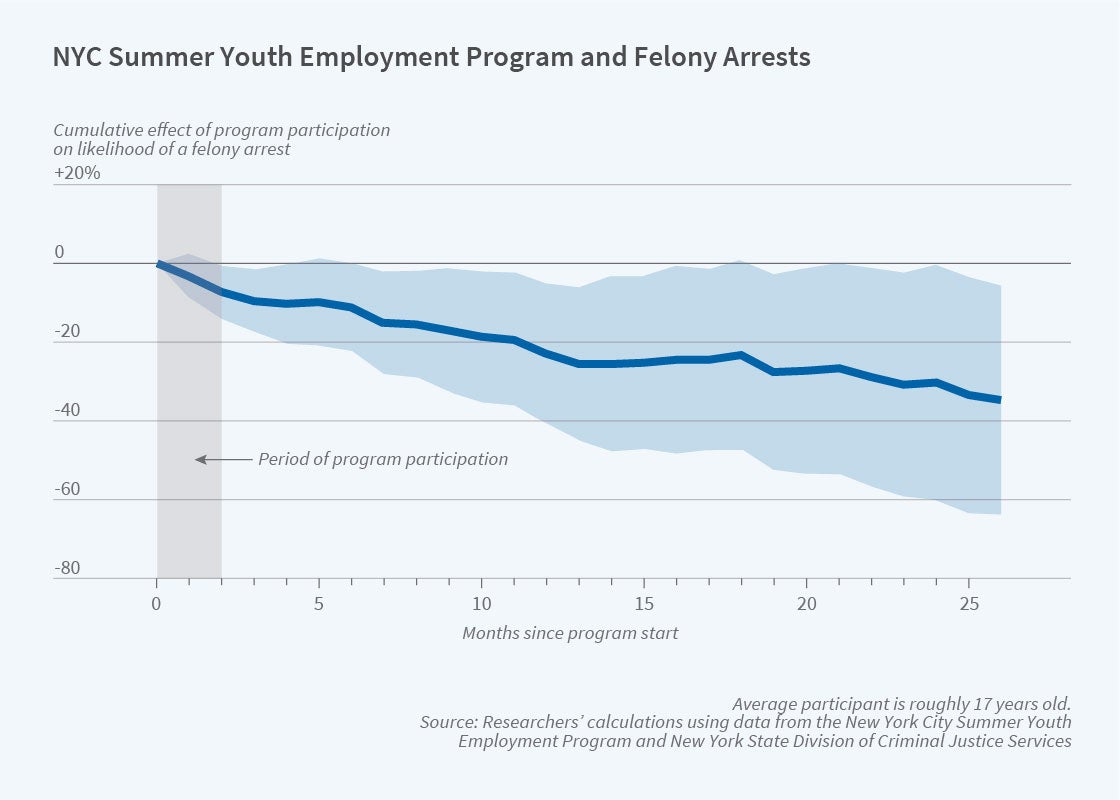NYC’s Youth Summer Jobs Program and the Rate of Criminal Activity

Participation decreases the chance of any arrest during the program summer by 17 percent, and the chance of a felony arrest by 23 percent.
A key goal of youth employment programs is reduction in young people’s involvement with the criminal justice system. In The Effects of Youth Employment on Crime: Evidence from New York City Lotteries (NBER Working Paper 28373), Judd B. Kessler, Sarah Tahamont, Alexander M. Gelber, and Adam Isen explore whether participation in summer youth employment programs (SYEPs) has a significant effect during the summer of the program or only after the summer ends. They investigate whether participation decreases the chance that youth end up in contact with the criminal justice system, and whether there are benefits for youth who are not at high risk for criminal activity before participating in the program.
The researchers link four years of data from the New York City Summer Youth Employment Program — the country’s largest such program — to criminal records data maintained by the New York State Division of Criminal Justice Services, enabling them to investigate the outcomes of 163,447 youth who participated in New York’s SYEP lottery between 2005 and 2008. Because the New York SYEP draws from a broad swath of youth, they are able to analyze the program’s effect on both at-risk and low-risk youth. About 3 percent of the applicants had been arrested before the program summer; the researchers deem them to be at risk of future contact with the criminal justice system.
The researchers find that participation in SYEP decreases the chance that a participant is arrested during the program summer by 17 percent, and decreases the chance they are arrested for a felony during the program summer by 23 percent. Effects are still larger for arrests that lead to convictions: SYEP participation decreases the chance that youth are convicted of a crime committed during the program summer by 31 percent. The felony conviction rate drops by 38 percent. The total number of arrests — which differs from the chance of a participant being arrested because some youth are arrested multiple times during the summer — declines by 14 percent. The drop in arrests is driven primarily by the at-risk group — the 3 percent of youth studied who had prior contact with the criminal justice system. The researchers did not find a statistically significant impact on justice system involvement by either at-risk or low-risk youth in the years after the program summer.
The researchers estimate that the New York SYEP prevents 34 arrests per thousand youth in the program summer. Applying estimates from other studies of the social cost of crime, they conclude that the reduction in criminal activity and criminal justice system engagement associated with the program is worth between $650 and $1,250 per participant for the at-risk youth. Using the lower estimate suggests that the benefits of averted arrests during the program summer cover about 47 percent of program costs for at-risk youth; the higher valuation estimates would imply almost complete coverage of program costs. Estimated benefits for the low-risk group are dramatically lower, in the range of $2 to $3 per participant. The researchers conclude that the criminal justice social cost savings of the program are largely concentrated among the at-risk population.
— Lauri Scherer


